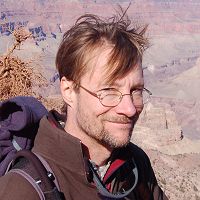Greg Tucker awarded the Ralph Alger Bagnold Medal 2012
24 Apr 2012
News Source: European Geosciences Union
The 2012 Ralph Alger Bagnold Medal is awarded to Gregory E. Tucker for his innovative modeling and field studies.
Greg Tucker has made critical contributions to a large number of topics in geomorphology. He has been one of the pioneers in the use of two-dimensional landscape evolution models. He did not use them to study a particular issue or problem, but rather to explore how basic properties of geomorphic systems could be related to the landforms these systems produced, over a wide range of both temporal and spatial scales. By doing so, he has convincingly shown that geomorphic models that integrate all relevant processes can indeed make a decisive difference in furthering our understanding of landscape evolution. His work was seminal in showing how different processes may interact in order to produce, in some cases, unexpected and counterintuitive results, even when large landforms are considered. A prime example of this is one of his first publications on the modeling of the erosional dynamics of escarpments where he demonstrates that supply-limited conditions are a necessary prerequisite to produce high, long-lived escarpments. Widely cited modeling work of a few years later that he did together with Rafael Bras demonstrated that different assumptions on runoff and sediment production on hillslopes do indeed produce distinctive morphologies and drainage density-relief relationships. Together with Erkan Istanbulluoglo and others he also showed how vegetation potentially modifies long-term landscape response, a fact that is all too often forgotten in long-term landscape studies. Tucker’s contributions, however, are not limited to the study of soil-hillslope-drainage basin interactions. Together with Rafael Bras and others he went on to study the effects of event variability on landscape development, a welcome divergence of the steady-state assumptions that are used in most studies (Tucker and Bras, 2000). Variability has been an important theme in his work ever since Tucker conclusively showed that many aspects of drainage basin behaviour cannot be properly understood if temporal variability in the driving forces is not accounted for. Tucker has not modelled in isolation: throughout his career he has been interacting with field geomorphologists and he has been confronting models with empirical data wherever possible. This led to insightful papers on the factors controlling the development of arroyos (Tucker et al., 2006) as well as insights which may help guiding future erosion studies with cosmogenic nuclides in landslide-prone areas and the interpretation of geoarcheological archives. Finally, Tucker should not only be honoured for his important scientific contributions to geomorphology (the account above is but a small sample) but also for his clear scientific writing. Tucker’s papers excel in clarity, whereby things are looking simple, perhaps simpler than they really are. Many young scientists have been attracted to the theoretical aspects of our discipline through the papers of Tucker, and through the way he has made modeling tools like “Golem” and “Child” trademarks in the geomorphic community.
News Source:
READ MORE from European Geosciences Union >>
News Category:
AWARD
Explore Further


